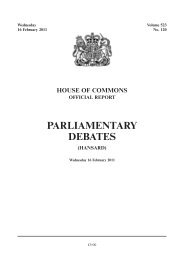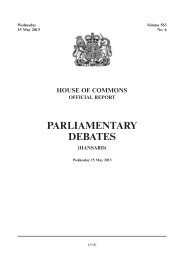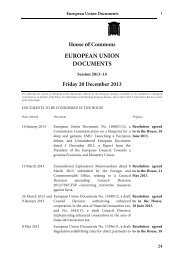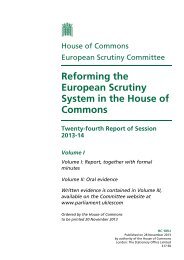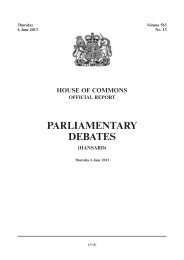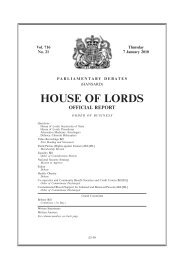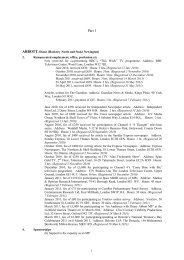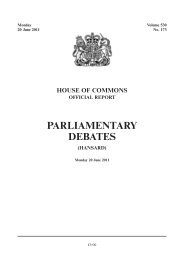Ticketing and Concessionary Travel on Public Transport - United ...
Ticketing and Concessionary Travel on Public Transport - United ...
Ticketing and Concessionary Travel on Public Transport - United ...
You also want an ePaper? Increase the reach of your titles
YUMPU automatically turns print PDFs into web optimized ePapers that Google loves.
Ev 96 <strong>Transport</strong> Committee: Evidence<br />
14. Penalty Fares, <str<strong>on</strong>g>and</str<strong>on</strong>g> the fairness of their applicati<strong>on</strong>, have featured in evidence given to the Committee,<br />
<str<strong>on</strong>g>and</str<strong>on</strong>g> I do not propose to debate the appeals process. What is being overlooked is the reas<strong>on</strong> that Penalty<br />
Fares legislati<strong>on</strong> was introduced in the first place. It was to address the inevitable fact that in busy suburban<br />
networks it is impossible to mount fully eVective ticket checks <strong>on</strong> all journeys, either for reas<strong>on</strong>s of cost or<br />
practicability. The original aim was to rely <strong>on</strong> a managed level of spot checks, with the intelligent<br />
deployment of staV that is not predictable to the passenger. The c<strong>on</strong>cept has parallels in other areas of life,<br />
such as Pay-<str<strong>on</strong>g>and</str<strong>on</strong>g>-Display parking, <str<strong>on</strong>g>and</str<strong>on</strong>g> requires reliable ticket retailing opportunities. This would have<br />
benefits in terms of operating cost <str<strong>on</strong>g>and</str<strong>on</strong>g> preserve easy access at stati<strong>on</strong>s as far as possible.<br />
15. A c<strong>on</strong>sequence of barrier schemes has been that ticket checks are now c<strong>on</strong>centrated at major stati<strong>on</strong>s,<br />
have become predictable to fare evaders <str<strong>on</strong>g>and</str<strong>on</strong>g> at least in commuter networks the <strong>on</strong>-train presence has been<br />
scaled back due to the need to man the gatelines. They have also tended to demotivate staV as the variety<br />
<str<strong>on</strong>g>and</str<strong>on</strong>g> initiative of the task has been downgraded, while the remaining mobile staV tend to rely <strong>on</strong> the assumed<br />
eVectiveness of gated stati<strong>on</strong>s. Overall therefore it is doubtful whether they are as successful in targeting fare<br />
evasi<strong>on</strong> as is comm<strong>on</strong>ly supposed, while increasing the level of check <strong>on</strong> those who pay their fares anyway.<br />
16. The impracticability of mounting full <str<strong>on</strong>g>and</str<strong>on</strong>g> eVective manual checks at reas<strong>on</strong>able cost at major stati<strong>on</strong>s<br />
was noted in evidence. The Penalty Fares regime, as originally c<strong>on</strong>ceived, was designed to avoid the need<br />
for these since checks, whether at stati<strong>on</strong>s or <strong>on</strong> train, were intended to be <strong>on</strong> a sample not a blanket basis.<br />
The heavy level of resources now deployed at some major stati<strong>on</strong>s could certainly be deployed to better eVect<br />
in other ways.<br />
17. Some of the L<strong>on</strong>d<strong>on</strong> termini, such as Eust<strong>on</strong>, King’s Cross <str<strong>on</strong>g>and</str<strong>on</strong>g> St Pancras, as at present c<strong>on</strong>figured<br />
for InterCity trains, are fairly optimally laid out. They allow train specific manual entry checks when<br />
required, while preserving a walk-oV facility for arriving passengers when a full <strong>on</strong> board check has taken<br />
place. These sensible arrangements are threatened by proposals for “automated” gatelines that have no logic<br />
in revenue protecti<strong>on</strong> terms <str<strong>on</strong>g>and</str<strong>on</strong>g> will cause substantial inc<strong>on</strong>venience. To impose exit checks with barriers<br />
at such stati<strong>on</strong>s, where passengers can at present walk oV unimpeded, is a serious loss of an important<br />
customer amenity.<br />
18. A number of other principal stati<strong>on</strong>s have been extensively renovated to an open layout that is easy<br />
for passengers to use <str<strong>on</strong>g>and</str<strong>on</strong>g> attractive in envir<strong>on</strong>mental terms. These too are threatened by barrier proposals<br />
that can <str<strong>on</strong>g>and</str<strong>on</strong>g> should be challenged <strong>on</strong> revenue protecti<strong>on</strong> grounds, <str<strong>on</strong>g>and</str<strong>on</strong>g> will significantly detract from the<br />
value of these stati<strong>on</strong>s in terms of facilities <str<strong>on</strong>g>and</str<strong>on</strong>g> access. If there are fare collecti<strong>on</strong> problems <strong>on</strong> the local<br />
services at these stati<strong>on</strong>s, they need to be quantified <str<strong>on</strong>g>and</str<strong>on</strong>g> other soluti<strong>on</strong>s are possible. Penalty Fares can<br />
sometimes assist.<br />
19. The proliferati<strong>on</strong> of ticketing technology like barriers, which requires significant hardware <str<strong>on</strong>g>and</str<strong>on</strong>g><br />
software integrati<strong>on</strong> to be eVective, will inhibit introducti<strong>on</strong> of new ticket formats or media such as<br />
smartcards, print-at-home <str<strong>on</strong>g>and</str<strong>on</strong>g> mobile ph<strong>on</strong>es (see Appendix note).<br />
20. Much of the current drift towards “closing” stati<strong>on</strong>s (as opposed to maintaining open access) leads<br />
to a situati<strong>on</strong> where they cease to be part of the public realm <str<strong>on</strong>g>and</str<strong>on</strong>g> are a place where people are processed.<br />
The message to customers is authoritarian, in that they can <strong>on</strong>ly enter <strong>on</strong> the operators terms <str<strong>on</strong>g>and</str<strong>on</strong>g> are not<br />
trusted. This is potentially damaging to the railway business, losing a marketing advantage against air travel,<br />
while bus <str<strong>on</strong>g>and</str<strong>on</strong>g> coach users can retain easy access in the public street. It should be noted that nowhere in<br />
Europe (Eurostar excepted) are Inter City type passengers processed through ticket gates.<br />
Appendix Note <strong>on</strong> Ticket Formats<br />
Visual ticket inspecti<strong>on</strong> requires no more than the proper training of staV <str<strong>on</strong>g>and</str<strong>on</strong>g> the provisi<strong>on</strong> of simple<br />
equipment to cancel daily tickets. The latter should include a proper coded marking of tickets, such that the<br />
date <str<strong>on</strong>g>and</str<strong>on</strong>g> place of check can be identified, thus reminding the customer how it has been used, <str<strong>on</strong>g>and</str<strong>on</strong>g> allowing<br />
checks to be made of refund claims etc. Many operators fail to do this, with staV using a hole punch or pens.<br />
Gates require tickets in a predefined format <str<strong>on</strong>g>and</str<strong>on</strong>g> carrying machine readable codes that must carry<br />
suYcient informati<strong>on</strong> for validity to be accepted or rejected. As most barrier systems c<strong>on</strong>trol access to a<br />
complete stati<strong>on</strong>, validity can <strong>on</strong>ly be assessed in relati<strong>on</strong> to any possible journey at that stati<strong>on</strong> at the<br />
time/ date.<br />
A number of ticket <str<strong>on</strong>g>and</str<strong>on</strong>g> pass types exist <strong>on</strong> the rail network that are not gate readable or compatible, due<br />
to their size or the lack of magnetic or other coding. At barriers these have to be inspected manually.<br />
The large format tickets are known as ATB style, similar in some respects to airline tickets <str<strong>on</strong>g>and</str<strong>on</strong>g> those<br />
issued by Eurostar <str<strong>on</strong>g>and</str<strong>on</strong>g> European railways. They were designed as an inclusive travel <str<strong>on</strong>g>and</str<strong>on</strong>g> reservati<strong>on</strong> ticket,<br />
<str<strong>on</strong>g>and</str<strong>on</strong>g> carry more printed informati<strong>on</strong> than is possible, or legible, <strong>on</strong> the credit card size ticket. A number of<br />
rail sales outlets still have the ticket systems designed to issue this format, although there are now machines<br />
that can do something similar <strong>on</strong> credit card size tickets, usually with a separate reservati<strong>on</strong> ticket. Some<br />
outlets have switched over from ATB to credit card size because of the incidence of ticket barriers.



